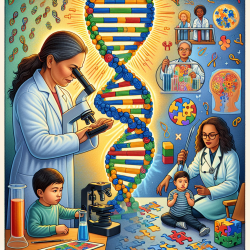Introduction
In recent years, exome sequencing (ES) has emerged as a crucial tool in pediatric genomic medicine, offering significant diagnostic and clinical utility for patients with suspected genetic disorders. A recent study titled Disease-associated mosaic variation in clinical exome sequencing: a two-year pediatric tertiary care experience sheds light on the importance of detecting mosaic variation, which can significantly enhance diagnostic yield and improve outcomes for children.
Key Findings
The study analyzed clinical ES data from 357 pediatric probands over two years, revealing a diagnostic yield of 32.2%. Notably, de novo variants accounted for 64.9% of disease-associated variations, and mosaic variation was identified in 6% of the cases. These findings underscore the critical role of ES in detecting low-frequency mosaic variants, which are often missed by traditional sequencing methods.
Implications for Practitioners
For practitioners in speech language pathology and related fields, these insights are invaluable. Here are some actionable steps to consider:
- Incorporate Exome Sequencing: Advocate for the use of ES as a first-tier diagnostic tool for children with unexplained developmental delays or genetic disorders.
- Focus on Mosaicism: Recognize the significance of mosaic variants in genetic disorders, particularly in neurodevelopmental conditions. This awareness can guide more accurate diagnoses and personalized interventions.
- Collaborate with Geneticists: Work closely with geneticists to interpret ES results and integrate genetic insights into therapeutic plans, enhancing the effectiveness of interventions.
- Stay Informed: Keep abreast of advancements in genomic medicine and emerging research to continually refine diagnostic and therapeutic approaches.
Encouraging Further Research
The study highlights the need for ongoing research into the detection and implications of mosaicism in genetic disorders. Practitioners are encouraged to engage in collaborative research efforts and contribute to the growing body of knowledge in this field. By doing so, they can play a pivotal role in advancing diagnostic accuracy and improving outcomes for children with genetic disorders.
Conclusion
Exome sequencing is revolutionizing pediatric genomic medicine by enhancing our ability to detect and understand genetic variations, including mosaicism. For practitioners, integrating these insights into clinical practice can lead to more accurate diagnoses and better outcomes for children. As we continue to explore the potential of ES, collaboration and continued research will be key to unlocking its full benefits.
To read the original research paper, please follow this link: Disease-associated mosaic variation in clinical exome sequencing: a two-year pediatric tertiary care experience.










